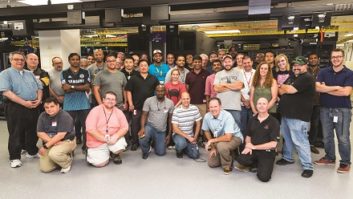The FCC is continuing to take steps to update its Web and IT infrastructure, most recently by presenting a beta version of the FCC.gov website.
But the story started this summer, when the agency upgraded its IT systems, which involved physically moving more than 200 different legacy servers out of FCC’s headquarters to a commercial service provider.
That entire process was apparently a bit of an Ocean’s Eleven mission, as the FCC’s Chief Information Officer David Bray opined in a video posted on his Twitter feed about the move, complete with Elvis Presley’s “A Little Less Conversation.”
In an interview with Radio World, Bray offered details on how the upgrade played out, and gave a glimpse of what’s next for the agency.
Radio World: Are all areas that were involved in the IT upgrade again up and running?
David Bray: All systems are fully operational again.
RW: Were there any systems that did not make the move over?
Bray: Before the move we planned to retire some of our oldest hardware, including two 11-year old servers that weighed one ton each. We successfully transferred systems from older hardware to newer hardware and all systems are operational again. In terms of sheer weight of servers, the FCC’s headquarters are much “lighter” as a result.
RW: How much of the move was a physical one — where large-scale boxes were moved to a different data center — as opposed to an upload into a cloud competing center?
Bray: In short, nearly all of it. We moved more than 200 servers to a commercial data center and then reconnected the complex network of cables linking those servers to our offices and online systems. While some FCC systems already have transitioned to the cloud — including our Consumer Help Center — this server move was more about positioning the agency to be able to shift more systems to resilient, efficient, cloud-based operations.
We also retired some of our oldest hardware to newer hardware, and now that we have FCC’s servers in a commercial data center we’ll work with commercial vendors to transfer remaining FCC legacy IT systems to the cloud.
RW: Can you give some sense of the scale of the modernization effort?
Bray: More than 200 physical servers and almost 400 programs were unplugged, moved, and reconnected over the course of a few days. There were tens of thousands of cables, cords, and connections that had to align perfectly and seven moving trucks of equipment.
RW: Did you run into any major roadblocks?
Bray: Any project of this scale has complicated pieces and opportunities for surprises. I wish ultra-high-speed 4Gbps Wi-Fi was here today so we didn’t have to worry about thousands of cables in a commercial data center. However today’s commercial data centers still require thousands of cables. Recreating our original network topology at the commercial data center took longer than we hoped, but we worked through it, and all of FCC’s data arrived safe and intact.
RW: What were the major goals of the modernization effort?
Bray: We are striving for a lighter, leaner, more efficient federal government. To contribute to this, we want to improve IT efficiency (operational and energy), strengthen network resiliency, position ourselves to move more systems into advanced cloud-based operations onsite at a commercial data center, and conserve financial and management resources. We did this to be good stewards of the taxpayers’ dollars and avoid the ever-increasing costs of maintaining our legacy servers on-site at the FCC.
RW: Have those major goals been achieved?
Bray: We are on track to realize these goals with more to come in the months ahead. This event also helped forge stronger partnerships between the commercial vendors and government teams. Both parties now collectively understanding FCC’s systems better and are working together toward moving everything to the cloud longer-term. Working with the private sector, we’re stronger as a result of this server move.
RW: What are the next steps for the modernization of the commission’s IT infrastructure?
Bray: Now that we’ve moved our servers to a commercial data center, we’ll plan to move more FCC systems into the cloud and upgrade their scalability and interoperability, just as we successfully did with the FCC’s Consumer Help Center.










